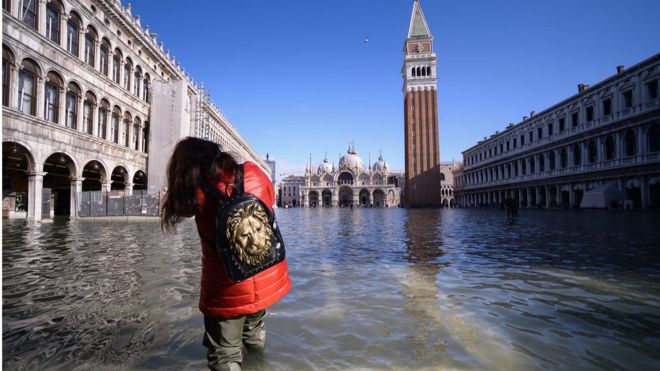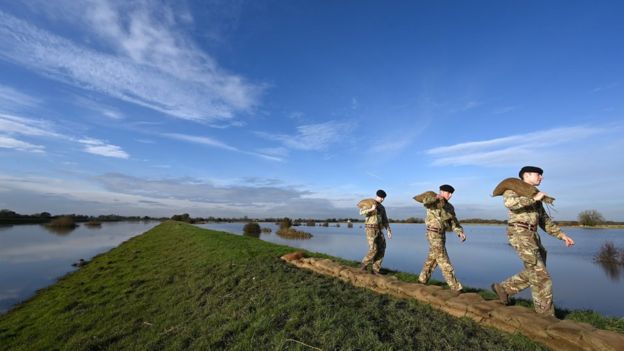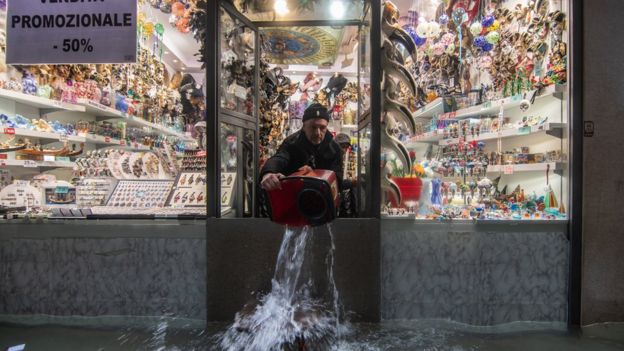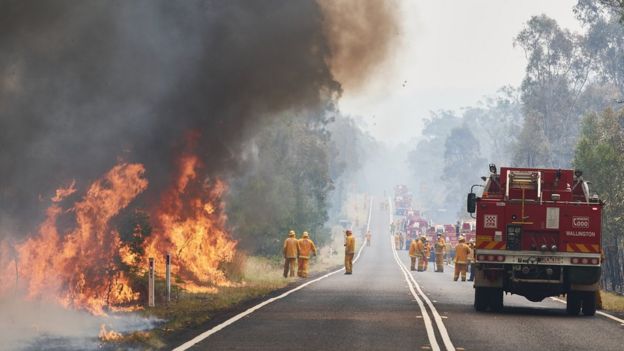Climate change: Warming signal links global floods and fires
Science & Environment Climate change: Warming signal links global floods and fires By Matt McGrath Environment correspondent
Climate change: Warming signal links global floods and fires
 GETTY IMAGES
GETTY IMAGESWith homes under water in South Yorkshire, near record flooding in Venice, and burgeoning wildfires in Australia, many people are asking if and how climate change is connected to these extreme weather events.
- Warming makes bigger hurricanes more damaging
- BA reviews 'fuel-tankering' over climate concerns
- Speed limits for ships can have 'massive' benefits
What can we say about the role of climate change in floods like those seen in South Yorkshire?
There are some basic physical factors that help explain the scale of the downpours that recently swamped the village of Fishlake and other locations in Yorkshire, Derbyshire and Lincolnshire.
The very scientific sounding Clausius-Clapeyron equation is one key element.
Clausius and Clapeyron are the surnames of the German and French meteorologists who discovered that a warmer atmosphere holds more moisture. For every 1 degree C increase in temperature, the air can hold about 7% extra water vapour.
When you get the sorts of storms that generate rapid cooling, you get heavier rain falling rapidly out of the clouds, as happened in parts of England last week.
 GETTY IMAGES
GETTY IMAGES"As temperatures are warmer we get more intense rain, which by itself brings more floods, even if the number of storms hitting our shores don't change," said Prof Piers Forster from the University of Leeds.
"When coupled to warmer, wetter winters generally, as expected from climate change, the ground becomes more saturated so any rainfall will give a greater chance of flooding."
This is, in essence, the scenario that played out in Fishlake last week.
Will we see more such flooding in the near future?
UK scientists observe and predict a 10-20% increase in rainfall during the wettest days, so it is very possible that we will see other examples of this type of downpour across this winter.
In coastal areas, the chances of flooding are made worse by the rise in sea level.
However, the chances of an area flooding or not is also complicated by human factors such as farming practices, the building of houses on flood plains and the vagaries of the British weather.
What about Venice?
Venice has been hit by floods that have seen more than 80% of the city, a Unesco world heritage site, under water when the tides were at their highest.
The Mayor of Venice was very quick to attribute the floods to climate change. Critics though have pointed to delays and corruption in relation to the installation of a major floodwater defence system that might have limited the damage.
 GETTY IMAGES
GETTY IMAGESClimate scientists, however, see a clear relation between rising temperatures and the inundation.
"Sea level rise is rising globally and it is also rising in the Adriatic," said Prof Gabi Hegerl, from the University of Edinburgh.
"Venice is also subsiding a bit, so you have a bit of a double whammy.
"The immediate flood has been caused by the Sirocco wind and the high tides but it wouldn't have been as high without the sea having risen as well."
What about the Australian fires - where's the climate link?
The latest Lancet report on health and climate change "found that human exposure to fires had doubled since 2000".
"Wildfires not only cause deaths and health damage but had significant economic and social impacts," it found.
 ECMWF COPERNICUS
ECMWF COPERNICUSIn Australia, the bushfires this year have come far earlier and on a larger scale than seen previously.
While climate change doesn't directly cause fires like these - it is major factor in creating the right conditions for fires to take hold.
"In areas like Australia where we have had prolonged dry periods, you can't definitely attribute this to climate change but the environmental conditions are increasingly ripe for these sorts of things," said Prof Nigel Arnell from the University of Reading.
"The precursors are all going in the direction of increased fire risk in those fire-prone regions."
Other researchers also point to indirect links.
"Most droughts are found to be in part caused by climate change," said Prof Piers Forster.
"Stronger winds, again associated with more energy in the climate system, add to the fire risk and make them more intense and faster moving."
Are there common climate factors in all these events?
Very much so, say the scientists.
"The overall climate signal is that if you have it warmer, it is easier to burn; if you have higher seas, it is easier to flood," said Prof Gabi Hegerl.
"And if you have more moisture in the atmosphere, the same rainfall systems rain harder - that is something we see globally and that has a human greenhouse gas signal in it.
"In extreme events, that's where climate change bites us."
Have climate models predicted these events?
"Our climate models that project the future are best at the mean, at looking at the averages," said Prof Arnell.
"They are not necessarily designed to be good at extremes, so we haven't got a prediction of extremes to compare against."
Other researchers say that what we are now experiencing is very much in line with models but that the world hasn't been adequately prepared for the scale of what we are now seeing.
 GETTY IMAGES
GETTY IMAGES"I think there is a case to be made that scientists under-predicted the societal and environmental impacts of such events," said Prof Piers Forster.
"But the projection of global temperature change and associated climate impacts has been pretty well predicted since the first Intergovernmental Panel on Climate Change report was published in 1990, or even before."
How does the insurance industry view all this?


